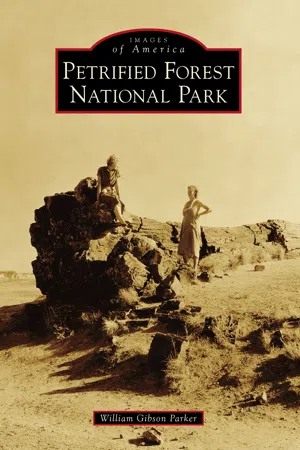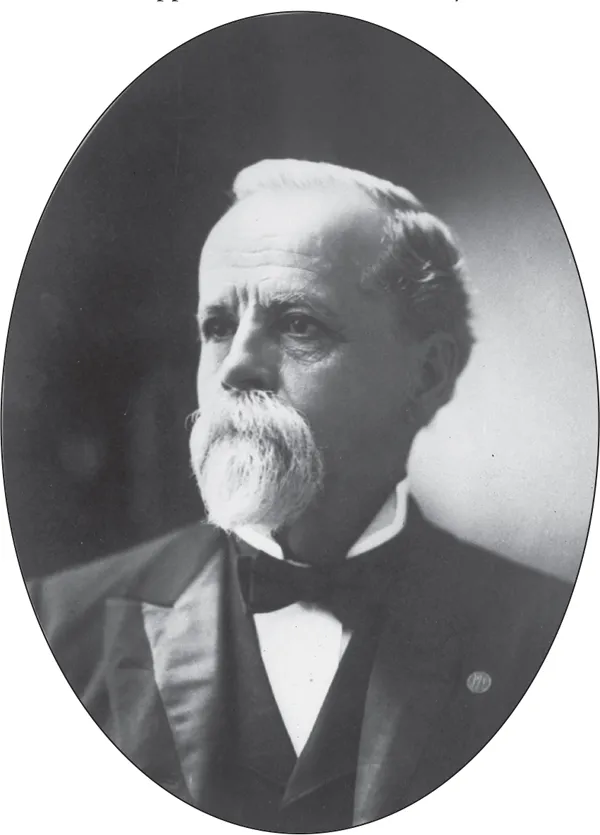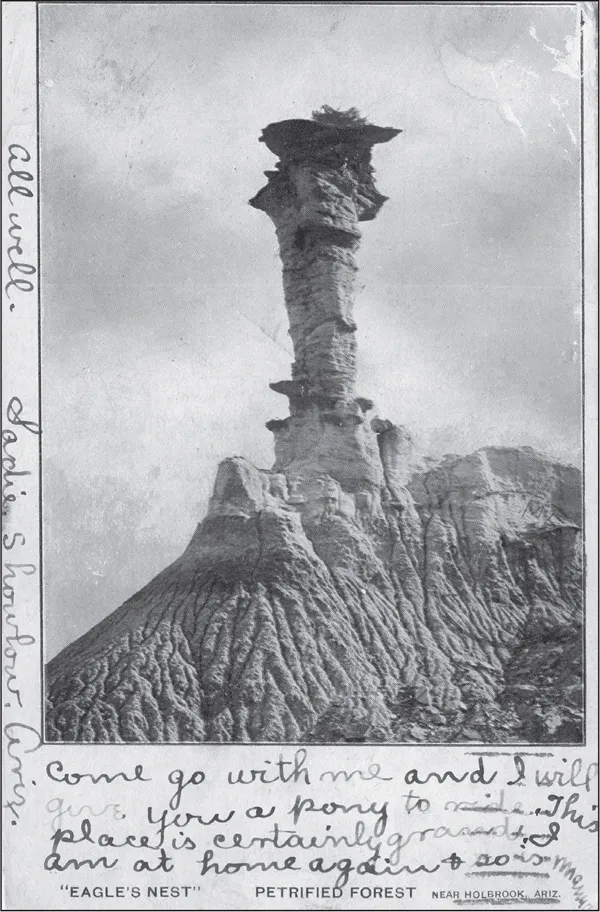![]()
One
CHALCEDONY PARK
Although long known and utilized by native peoples, the Petrified Forest was first historically documented in 1851 by the Sitgreaves Expedition. Two years later, the Whipple Expedition discovered the Black Forest while surveying the 35th parallel. Swiss geologist Jules Marcou determined that the wood likely was from the Triassic Period, and the scene was recorded by expedition artist Balduin Möllhausen with this woodcut in his Diary of a Journey from the Mississippi to the Coasts of the Pacific. (NPS/PEFO 24460.)
Word of the “Forests of Stone” spread, and prospectors placed claims over the best areas. One such pair consisted of “Petrified” William Adams and S.L. Shaw, who in 1885 set up at what is now called Agate Mesa, christening the area “Chalcedony Park.” Adams and Shaw sold the petrified wood and shipped out 18 tons worth by 1888. (NPS/PEFO 18810.)
Removal of the petrified wood prompted early conservation efforts. In 1885, the Arizona territorial legislature called on Congress to set the area aside as a national park. Early efforts were championed by Sen. John Fletcher Lacey, but all were unsuccessful. Lacey was an eight-term Republican senator from Iowa who wrote the Antiquities Act, which provides the president the ability to protect areas of scientific interest as national monuments. (NPS/PEFO 23509.)
Early visitors arrived by train and were taken by guides from Holbrook or Adamana through the various “forests,” as the large accumulations of petrified wood were commonly called. They were named in the order they were reached, the First, Second, and Third Forests. Travel to the Third Forest required overnight camping. (NPS/PEFO 15845.)
A mother and her small children are pictured in the First Forest in 1903. The photograph is labeled “Agatized Ruins of a Great Primeval Forest Near Adamana, Arizona.” Despite the apparent remoteness of the site, its proximity to the railroad made it easy to visit. (NPS/PEFO 34111.)
Rock formations such as Eagle Rock, named for the eagle’s nest found on it, were destinations for the earliest explorers and visitors. Eagle Rock is an erosional rock pinnacle that was commonly photographed by early visitors and also featured in numerous postcards purchased to send back home. The site was in the First Forest, a prominent part of Chalcedony Park, until its collapse in 1940. Rock formations in the badlands enhanced the area’s reputation as a place to see for the adventurous. Having one’s photograph taken standing next to Eagle Rock was very common among visitors as well as the park rangers. (Above, NPS/PEFO 24504; left, NPS/PEFO 2822E1.)
Another prominent feature of Chalcedony Park was the natural bridge, a 100-foot-long petrified log that spans a gully. It was popular for early visitors to have their photograph taken on the log. In the late 1800s, a cowboy named John Paine won a $10 bet by successfully riding his horse across the log. (Henry Peabody, NPS/PEFO 18914.)
Afraid for the collapse of this popular feature, the Santa Fe Railway constructed support pillars underneath in 1911. The original pillars were replaced in 1917 by a steel-supported concrete beam, which is still at the site today. It is unclear how long this feature would have lasted without this support, as collapsed “bridges” are present in other parts of the park. (NPS/PEFO.)
Shortly after his arrival in 1895, rancher Adam Hanna supplemented his income by providing tours of Chalcedony Park. Hanna also served as the postmaster and brokered the removal of several train carloads of wood in 1899. Hanna was an opponent of early attempts to protect the area as a national park. The photograph above shows Hanna behind several large log pieces, probably in the First Forest, and the photograph below shows him perched on top of the Natural (Agate) Bridge in 1899. Hanna left the area in 1907 shortly after the monument was created. (Above, NPS/PEFO 24860; below, NPS/PEFO 2912.)
In 1898, the Santa Fe Railway built a railroad station north of the park. It was named Adamana, a contraction of Adam Hanna’s name. Adamana would serve as the unofficial park headquarters until 1924. That the station name was an amalgamation of Hanna’s first name with his wife, “Anna,” is a longstanding, oft repeated, claim, but it is false. Mrs. Hanna’s first name was actually Maggie. (NPS/PEFO 34559A.)
The Forest Hotel was constructed in Adamana in the late 1800s and served visitors for over 60 years. Hotel owners ran the livery service to the park, and after the establishment of the monument and for the next 18 years, whoever owned the hotel also served as the monument custodian. The hotel stayed in business until it burned in 1966. Here is a wagon set to depart from the hotel in 1895. (NPS/PEFO 15837.)
The most common place to visit was the First Forest, as it was the closest to Adamana. Besides Eagle Rock and the Natural Bridge, a sandstone feature known as the Snow Lady was a common destination. Unfortunately, this structure, like the Eagle Rock, was a victim of erosion and collapse in the 1950s. (NPS/PEFO 24506.)
This is a common petrified wood scene in the First Forest, with the subjects standing among the log sections; however...















